|
Biography
Family
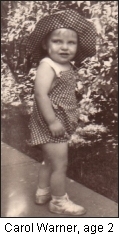 Carol
Ann Warner (Shields) was born on June 2, 1935 in Oak Park, Illinois.
Her mother, Inez, would say to friends — to Carol's mortification
— "Carol slipped out like a pound of butter". Carol joined
sister and brother twins, Barbara (Babs) and Robert (Bob), who
had been born a year-and-a-half earlier. Carol and Bob loved to
shoot baskets in their back lane as children. Carol
Ann Warner (Shields) was born on June 2, 1935 in Oak Park, Illinois.
Her mother, Inez, would say to friends — to Carol's mortification
— "Carol slipped out like a pound of butter". Carol joined
sister and brother twins, Barbara (Babs) and Robert (Bob), who
had been born a year-and-a-half earlier. Carol and Bob loved to
shoot baskets in their back lane as children.

There were three children.
I was the youngest of three. My mother was unusual in that after
we were launched in school she had a job. She was a schoolteacher.
She went back to school teaching. They needed teachers after the
(second world) war. Most of the mothers were stay-at-home mothers.
My father worked in an office. That's all I knew. It was an office
downtown, and the fathers disappeared, went off to work."
[Interview for the Academy
of Achievement, May 23, 1998]
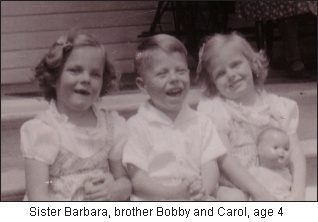

I have to say I didn't know
my father very well. He was a very remote figure. I don't think
-- and this is a very sad thing -- I don't think I ever had a
real conversation with him in my life, and I'm not quite sure
why that happened. Was it I who didn't initiate that or make him
feel at ease? I don't know. But certainly he was a gentleman."
[Interview for the Academy
of Achievement, May 23, 1998]
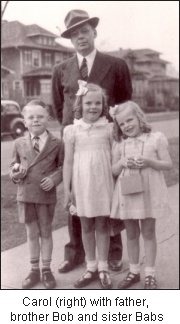 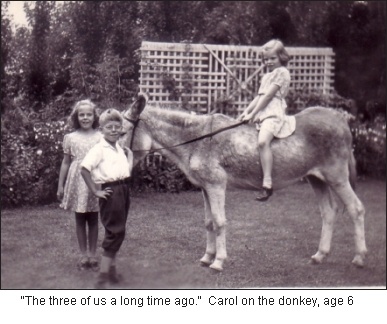

I grew up in Oak Park, Illinois.
It's a suburb, the first suburb on the west side of Chicago. We
didn't know Chicago. I grew up next to this wonderful city and
didn't know it. We stayed in our suburb, a very conservative,
very white, completely white suburb in those days -- completely
changed now -- tremendously conservative, everybody went to church.
I never met anyone who didn't go to church. And of course, it
had wonderful schools, small classes, extraordinary teachers.
We were a privileged lot in some ways. Where we weren't privileged
was in the breadth of our experience. It was a pretty narrow place
to grow up, very parochial. So you come out with a set of attitudes,
go away to university, and then you're surprised that the world
is so big, that there's so much more there."
[Interview for the Academy
of Achievement, May 23, 1998]
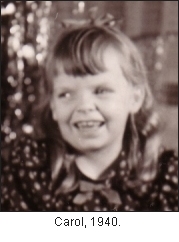 Carol
learned to read when she was four, and never stopped reading.
In grade one she loved Dick and Jane. To her, Dick, Jane,
Spot the dog, and Puff the cat were real. Carol knew they were
real because they filled her imagination, and she could picture
them going about their daily routines — just as she did. Carol
learned to read when she was four, and never stopped reading.
In grade one she loved Dick and Jane. To her, Dick, Jane,
Spot the dog, and Puff the cat were real. Carol knew they were
real because they filled her imagination, and she could picture
them going about their daily routines — just as she did.

I loved Dick and Jane, especially
Jane with her nice, clean white socks. I thought she was such
a nice little girl. I didn't quite believe, perhaps, in the perfection
of her life, but it wasn't that far from my own life. And Dick,
what a wonderful big brother he was. I read a lot into them I
think."
[Interview for
the Academy of Achievement, May 23, 1998]
School Days
Carol Shields would look back at her primary school days
and comment:

I attended Nathaniel Hawthorn
School and Ralph Waldo Emerson School. I knew the schools were
named after writers — both were male writers, both were dead.
I wondered if there were any female writers, live female writers.
Perhaps it was then that I started to question the dominance of
males in our lives.
"I wrote as a child. I was a schoolgirl
writer. Every school has one of these girls, you know, who writes
the class play, and writes the class poem, and everyone says,
"Oh, you're going to be a writer when you grow up." I didn't,
in fact, think I would. It felt like wanting to be a movie star."
[Interview for the Academy
of Achievement, May 23, 1998]
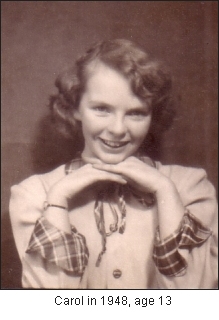 Carol
blossomed as a student at Oak Park High School, where she could
concentrate on history and English, and not have to be concerned
about science and math. Carol
blossomed as a student at Oak Park High School, where she could
concentrate on history and English, and not have to be concerned
about science and math.

I was one of those good students.
I was not good in certain things, mathematics for example, and
I took the bare minimum that I could. I would have done very badly
if I had gone ahead in physics, I suppose. But I chose things
that I excelled in — history, English, of course."
[Interview for the Academy
of Achievement, May 23, 1998]

There were seven hundred and fifty students in my high school
graduating class, and we were all white, every one. I always knew
something was wrong with it, but I never knew what it was until
I went away."
[Random Illuminations,
Eleanor Wachtel]
It was at Oak Park High that she wrote
poetry in earnest — most of it, she later confessed, "amateurish
and corny, often an ode to a national holiday or to autumn or
spring".
College
After high school in Oak Park, Carol Shields went off to college
in 1953.
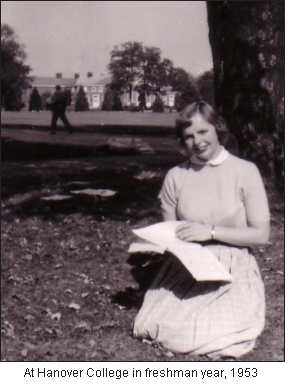 
Before I went away to college,
I had never spoken to a black or Asian person, never tasted garlic,
and never heard the work 'shit' uttered aloud. On the other hand,
I knew how to write a thank you note, which occasions demanded
hat and gloves, and how to conduct polite introductions."
[Interview with Sandra Martin,
Quill and Quire, February, 1998]
Carol chose Hanover College in Hanover,
Indiana. Since its founding in 1827, Hanover College's purpose
has been to provide a liberal arts education. The setting is idyllic
— 650 acres overlooking the Ohio River. The College's Board
of Trustees is independent of ecclesiastical control, but has
formally adopted the standards for Presbyterian colleges. Carol
was swept up by Alpha Delta Pi to be a sorority member. She was
Freshie Queen. Once again, Carol found herself in a privileged
white community. However, she had a glimpse of the lives that
were led by poor, rural people while practice-teaching across
the Ohio River in Kentucky.
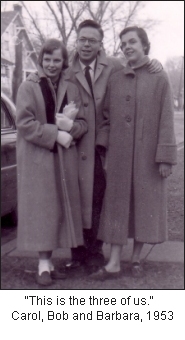

My parents very much wanted my brother to be an engineer. I'm
not quite sure how much he had to say about that. They wanted
my sister to get her teaching license. It was all right for me
to do a degree in English literature, as long as I did my education
credits as well. They were, of course, from the Depression, and
they wanted us to prepare for something that would be negotiable
in terms of employment, should we ever need it. My parents put
it this way: 'Something to fall back on,' and I knew what that
meant. It meant if we failed to find a spouse, if we were, God
help us, divorced or widowed, that we would have some way to earn
a living."
[Interview for the Academy
of Achievement, May 23, 1998]
In 1955, after two years at Hanover, Carol
Shields received a United Nations Scholarship to study abroad.
She chose Exeter University in Exeter, England in order to pursue
English literature. She once again found herself in an all-girls
residence, Lopes Hall. The University assigned her a male tutor
who would be her mentor for the year. When Carol presented her
tutor with the package of Hanover progress-report-sheets that
the tutor was to complete weekly, he tore them up and threw the
pieces into a wastebasket. Carol was in shock. She worried all
year about what Hanover would say on her return. Would she receive
credit for her year? Carol Shields received another shock when
it was explained to her that residence rules in Lopes Hall were
much less demanding than what she had been used to at Hanover.
When receiving a male visitor in the residence parlour, it would
not be necessary to have a chaperone present. All that was asked
of the girls in Lopes Hall was to keep one foot on the floor at
all times.
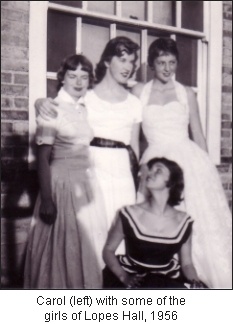

One lucky thing happened. I
went, during my third year, to Exeter University. It was a totally
different environment where we were not spoon-fed. We were on
our own in England. To go to lectures or not. People took their
subjects seriously. This was all a revelation to me, that people
would sit in the dining hall and talk about Christopher Marlowe.
It was wonderful."
[Random Illuminations,
Eleanor Wachtel]
Carol Shields returned to Hanover College
in the fall of 1956 for her final year. She graduated in June
1957 magna cum laude in History and Education.

My sister and I each had a degree, but we knew we would get married
and have children. The lives of middle class girls of my era were
highly predictable. No way did anyone ever think of having a career."
[Random Illuminations,
Eleanor Wachtel]
Love and Marriage
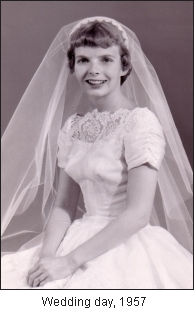 Over
the Christmas break while at Exeter University, Carol decided
to join a study group in Scotland. The opportunity was made available
to foreign students studying in Great Britain to learn more about
regional life in one part or other of the British Isles. About
30 students from a spectrum of nationalities - Indian, African,
European, and Asian - turned up in a remote inn outside Glasgow
for a seven day period. Among the others were three Canadian engineering
students who were studying in London. One was Donald Shields,
who would become Carol's husband a year-and-a-half later. Over
the Christmas break while at Exeter University, Carol decided
to join a study group in Scotland. The opportunity was made available
to foreign students studying in Great Britain to learn more about
regional life in one part or other of the British Isles. About
30 students from a spectrum of nationalities - Indian, African,
European, and Asian - turned up in a remote inn outside Glasgow
for a seven day period. Among the others were three Canadian engineering
students who were studying in London. One was Donald Shields,
who would become Carol's husband a year-and-a-half later.
Carol Warner and Don Shields were married
in Carol's parents' home in Oak Park on July 20, 1957. Don was
working in Vancouver, Canada. Carol and Don's honeymoon consisted
of driving from Chicago to Vancouver, where a week after their
marriage, Carol became a landed immigrant in Canada. Her Canadian
life had begun. Carol Shields became a Canadian citizen in March
1971.
Married Years
During their 46 years of married life, Carol and Donald Shields
lived in five Canadian cities, and one English city: Vancouver,
British Columbia (1957), Toronto, Ontario (1958-1960, 1964-1968),
Manchester, England (1960-1963), Ottawa, Ontario (1968-1978),
Vancouver (1978-1980), Winnipeg, Manitoba (1980-2000), and Victoria,
British Columbia (2000-2003). Year-long sabbatical leaves were
taken in Saint Brieuc, on the north coast of Brittany, France
(1976-77), Paris (1986-87), Berkeley, California (1993-94), and
London, England (1999-2000).
Son, John Douglas Shields, was born in
Toronto in April 1958. Daughters Anne Elizabeth Shields (Toronto,
October 1959), Catherine Mary Shields (Manchester, February 1962),
Margaret (Meg) Lorin Shields (Toronto, April 1964) and Sara Ellisyn
Shields (Ottawa, January 1968) followed.
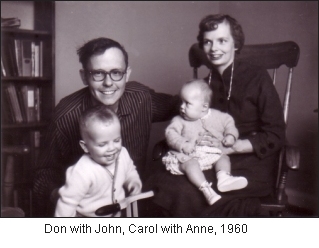

I loved having children. Physically
it was hard work, and I remember being tired a lot, but I can't
remember having the kind of frustration I've read that women with
young children can have. I was young and I had a lot of energy.
I hadn't started writing so I never felt, at that time, that the
kids were keeping me from writing."
[Random Illuminations,
Eleanor Wachtel]
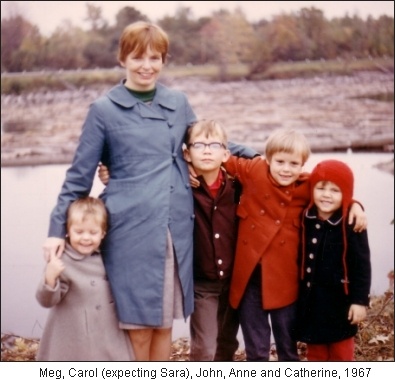

I couldn't have been a novelist
without being a mother. It gives you a unique witness point of
the growth of a personality. It was a kind of biological component
for me that had to come first. My children gave this other window
on the world."
[A Reader's Guide to
The Stone Diaries by BookClubs Canada, 2008]
Early Writing Years
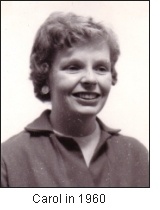 
At this time (1960), I gave
up any idea of becoming a writer, except for one thing. When she
first met him, my mother mentioned to my husband Don, 'I hope
you're going to encourage Carol to keep on writing'. Don remembered
this, and after I had my second child, he said, 'Why don't you
do something. There's a course at the University of Toronto in
magazine writing'. So, I went to that class. Towards the end of
the year, the woman lecturer actually wanted us to write something,
so I wrote a short story. Then I forgot about it. In the middle
of that summer, she phoned and said, 'I've sold your story to
the CBC'."
[Random Illuminations,
Eleanor Wachtel]
From September 1960 until November 1963,
the Shields lived in Manchester, England. In 1962, Carol sold
a short story to a British magazine, The Storyteller. This
was the first publication for which Carol was paid. The Storyteller
was a monthly magazine which was sold mainly in train stations
to travelers. The British Broadcasting Corporation also bought
a short story from Carol Shields in 1962. The story "For Business
Reasons" was broadcast in March of that year.
The Poet
Carol and her family returned to Canada
from Britain at the end of 1963 to live in Toronto for five years
before moving to Ottawa in 1968.

In 1964, the CBC had a competition
for young writers. I was twenty-nine; thirty was the cutoff. All
spring, I had this baby crawling around, and I wrote seven poems.
I hadn't written poetry since sonnets in high school. I worked
and worked on those poems. It was the first time in my life that
I took my writing seriously. In fact, I mailed them off the day
before the deadline. I won the competition. That led me into a
period of about five years when I wrote poetry."
[Random Illuminations,
Eleanor Wachtel]
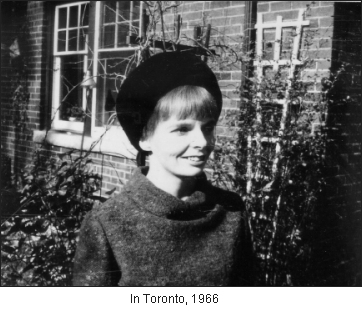
Carol Shields wrote a number of poems during
this period, many of which were published in literary magazines
such as The Canadian Forum, Books in Canada, and SALT.

I loved being a poet. I think partly
because a poem is such a small thing. I always think of it as
a kind of toy. You can get it almost right, and you can never
get a novel almost right because a novel is just too big. There
are just too many little parts to it, too many twigs and leaflets.
But a poem you can get just about right. And it was a very happy
writing time in my life, so that I never think of it now as
apprenticeship for novel writing."
[Interview for the Academy
of Achievement, May 23, 1998]

[By 1972] I'd had my fifth child, and she was going half-days
to school. I just had a little bit of time, and I was writing
poetry in those days. I was very interested in poetry for about
five years, in reading it and writing it. And eventually - these
were just published in small magazines in Canada. Eventually,
one of the professors at the University of Ottawa said, "Well,
look, we're in the publishing business. If you have 50 poems,
we will publish a book". So that, in fact, is what they did, and
they published another book two years later. So I had the two
books of poetry before I sat down to write a novel."
[Interview with Terry Gross
on Public Radio May 1, 2002]
The poems were collected together and published
in two books: Others in 1972, and Intersect in 1974.
Carol Shields was
an itinerant poet-in-the-schools for the Ottawa region in 1975.
The Master of Arts
Degree Years
The Shields lived in Ottawa from October 1968 until June 1978.
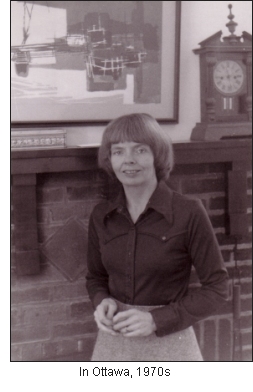 
I love Ottawa. Our children grew up
there, and they think of it as home. My husband was teaching
at the University [of Ottawa]; I went back as a graduate student
while we were there. We have a lot of good friends there. We
did feel very much at the centre of things living in the capital.
Actually I can not think of one bad thing to say about Ottawa.
I think it's a beautiful city."
[Interview with Tom Ashmore
on CBC Winnipeg, 1981]

I discovered feminism late. I knew there was something wrong,
I just didn't know what it was. But, of course, like many American
women, I read Betty Friedan's The Feminine Mystique and
it was like a thunderbolt. I was astonished. I had no idea women
thought like that or women could be anything other than what they
were. That was in the early '60s I read that book. It did change
the way that I thought about myself. I did begin to do a graduate
degree part-time, thought about doing some writing. It gave me
courage." (The Feminine
Mystique was published in 1963.)
[Interview with Terry Gross
on Public Radio May 1, 2002]

I signed up for an M.A. in Canadian literature. I started in 1969,
and there were hardly any mature students in the system. One of
our essays was about Susanna Moodie, and I decided to do my term
essay on her. When it came to the thesis ……. I remembered the
essay on Susanna Moodie, and I decided I would look at the work
we never look at in Canada — all those terrible novels she
wrote."
[Random Illuminations,
Eleanor Wachtel]
Carol received her M.A. degree in 1975.
Susanna Moodie: Voice and Vision, a literary essay based on Carol's
M.A. thesis, was published in 1976.
While working on her M.A., Carol had a part-time
job.

I was offered the first job of my
life. I became the editorial assistant on a scholarly quarterly
for two years [1973-1975], Canadian Slavonic Papers.
With small children, I did this work at home in my own little
workroom. The journal was edited at Carleton (University) so
I'd go in occasionally, but most of my work was done at home."
[Random Illuminations,
Eleanor Wachtel]
Becoming a Novelist
After receiving her M.A., Carol decided
to write a novel based on the material she had left over from
her thesis on Susannah Moodie. The novel eventually became Small
Ceremonies.

I wanted to write a novel
because I loved to read novels. I wasn't finding in the '70s the
kind of novels that had anything to do with my life or the sort
of women that I knew. I wanted to write a book that I couldn't
find, as it were."
[Interview for the Academy
of Achievement, May 23, 1998]
This was not the first attempt to write
a novel, for Shields had written a literary whodunit when taking
a break one year from her M.A. studies. She sent the manuscript
of the whodunit to a number of publishers. They all returned it
with encouraging comments, but none were willing to publish the
book.

The first manuscript that went
out came back. It was never published. It was a novel that I think
of now as my apprenticeship novel. I sent it to three publishers
- totally unsuitable publishers by the way. I knew nothing about
where to send things. But they all sent me lovely rejection letters,
and they all gave me some advice, and they each had the same advice
for me. So, I was encouraged by this."
[Interview with Diane Rheme,
US Public Radio, March 31, 1994]

I thought I would try again. Small Ceremonies went very easily.
And it was published just as I wrote it. It was so easy to do,
and it was wonderful, it was a very happy time. I sent (the manuscript)
to McGraw-Hill and they eventually accepted it. It was wonderful.
The week I turned forty, they phoned to say they were going to
take the novel, my two professors said they were going to publish
my thesis, and we were on our way to France - all in one week."
[Random Illuminations,
Eleanor Wachtel]
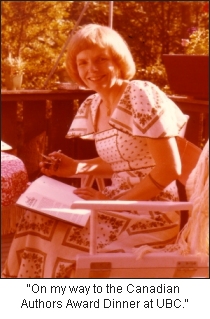 Small
Ceremonies was published in 1976. Carol was thrilled when
Small Ceremonies won the Canadian Authors Association Award. Small
Ceremonies was published in 1976. Carol was thrilled when
Small Ceremonies won the Canadian Authors Association Award.
When asked: How did you find the time to
write Small Ceremonies, Carol replied:

Everyone asks me this, including
my own children. What my children forget is that I did not have
a job; they are all raising children and having jobs. But I didn't
have a job. I didn't write until they went to school, and I didn't
write on weekends and I didn't write in the evening. None of this
was possible. But I used to try to get that hour just before they
came home for lunch, 11 to 12. You know, got all those socks picked
up, etc. and then I tried to write a couple of pages. That was
all I ever asked myself to do. Then sometimes, in the afternoon,
before they came home from school, I would get back to those two
pages, and maybe have a chance to do them over again. But I really
only had about an hour or an hour and a half a day. This was how
I organized my time, that I would give myself one or two pages
a day, and if I didn't get to my two pages, I would get into bed
at night with one of those thick yellow tablets of lined paper,
and I would do two quick pages and then turn off the light. I
did this for nine months, and at the end of nine months, I had
a novel. I could see how it could be done in little units. I thought
of it like boxcars. I had nine boxcars, and each chapter had a
title starting with September, and then October, November, December,
so it was a very easy structure for someone writing a first novel
to follow."
[Interview with Terry Gross
on Public Radio May 1, 2002]
Carol Shields wrote The Box Garden
during the sabbatical year 1975-76 living in St. Quay Portrieux
in Brittany. The novel was completed in nine months. It was published
in 1977.
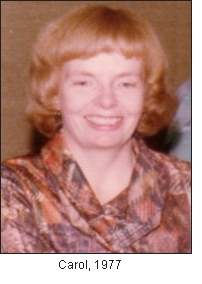 
I develop a novel as I go. I have a structure in mind, though.
I always see the structure before I know what's going to be in
the structure, and it's a very physical image that I can call
up. For each novel I've had rather a different structure, but
it's been important for me to have that. But I don't know where
it's going. I don't fully know the character of my main character
when I start out. So that character opens for me exactly as it
opens for the reader, piece by piece, layer by layer. I don't
know the whole plot. Sometimes I know where I want to get to;
I just don't know how I'm going to get there. This can be frightening
for a writer. After a point, you develop a certain faith in your
process."
[Interview for The Academy
of Achievement, May 23, 1998]
The Start of the Teaching
Years
Carol returned to Ottawa after the sabbatical year in France,
and started writing Happenstance while simultaneously teaching
creative writing at the University of Ottawa. Shields and her
family moved to Vancouver in mid-1978, where she continued to
work on Happenstance. During the 1978-79 and 1979-80 academic
years, Carol taught creative writing at the University of British
Columbia. Happenstance was published in 1980.
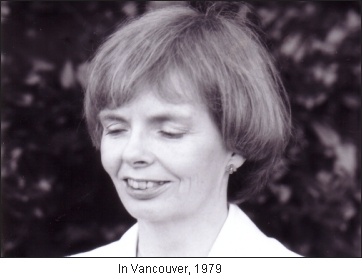
In the summer of 1980, the Shields family
moved to Winnipeg, where they would be based for the next twenty
years. Immediately on arrival in Winnipeg, Carol Shields signed
up to teach a course in writing at the Winnipeg Education Centre
in downtown Winnipeg. This was a rewarding experience; the students
were mature adults, many were Aboriginal, and they were mainly
women with limited formal education.
The following year, Carol was asked to teach
a course in communications to first-year engineering students
that fall. This was neither a happy nor fulfilling experience.
The last thing first-year engineering students wanted to be lectured
on at 8:30 in the morning were rules of English grammar. Carol
had a difficult time keeping the students interest and attention.
At the end of the academic year, Carol Shields decided never to
repeat that experience.
From the fall of 1982 onward, Carol Shields
taught in the English Department at the University of Manitoba,
first as an Assistant Professor (1982-1992), then as an Associate
Professor (1992 - 1995). Shields was made Full Professor of English
in 1995, and, on retirement in 2000, she became Professor Emerita
at the University of Manitoba.

I've come to feel very fond
of Winnipeg. The fact is — and this is a very unfashionable
admission — I came to Winnipeg because I was married to someone
who took a job at the University of Manitoba. I came with a great
deal of fear, partly I was afraid of the cold. I was sure it must
hurt to be as cold as that. I was afraid of the cultural isolation,
and that has not proven to be a fact. I am happy to say that.
I suppose I feel isolated when I look at a map, and that is the
only time."
[Interview by Terry Campbell
for the CBC "Talking with Artists Across the Country"]
The Early Publishing Years
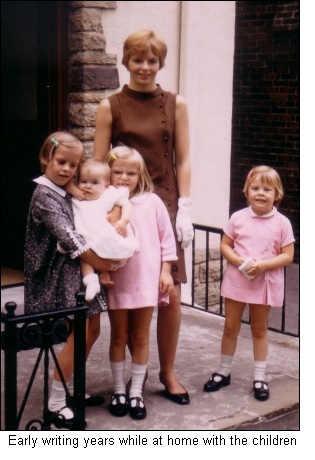 
I was a stay-at-home mother, and I did my writing at home. The
first novel I wrote on a portable typewriter - a non-electric
portable typewriter. It seems incredible now. Then I acquired
a second-hand electric typewriter, and then I acquired one of
those IBM ballistic affairs which I thought was the last word
in technology. I thought that I had gone about as far as I could.
I was rather late as a writer coming into the computer world.
When I did I, of course like everyone else, fell in love with
this little machine that smiled at me every morning and wished
me good morning.
"When I was a young mother writing
at home, I sometimes had the feeling that I was stealing time
in order to write my books - stealing time from my family. You
know, I could have been baking cookies for the kids or something
instead of up there with my little typewriter. This is why I
think it is so important for women writers to get that first
publication or that first grant, something that tells them what
you're doing is valuable, you can go on doing this. I suppose
having a successful career in writing does allow you to say:
I am a writer, and this is what I do. I need a little place
where I can do this, but I don't need much more. So most of
the time I think that being successful or not - what you're
doing is you're going into a little room and you're shutting
the door, and you're sitting there, and that's where you really
live.
"I didn't start writing until
[my children] were all in school. And I might say to writers
with young children, eventually children really do go to school.
I found, very gradually, that I had a little more time every
year to devote to writing. The first novel I wrote entirely
between 11:00 and 12:00 every day just before the kids came
home for lunch, and I very seldom got any more time during the
day to get back to that. I set myself a little task which was
to write two pages a day. Now it takes me all day to write two
pages. Then I could squeeze it into one hour."
[Interview with Diane
Rhem for US Public Radio, March 31, 1984]
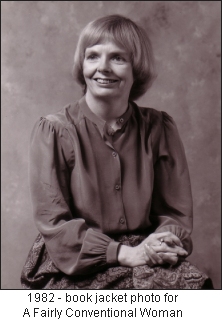 During
the years of transition, moving from Ottawa to Vancouver and finally
to Winnipeg, Shields was working on her fourth novel, a companion
piece to Happenstance called A Fairly Conventional Woman.
This novel was published in 1982. During
the years of transition, moving from Ottawa to Vancouver and finally
to Winnipeg, Shields was working on her fourth novel, a companion
piece to Happenstance called A Fairly Conventional Woman.
This novel was published in 1982.
In 1982, Carol Shields started her fifth
novel that would eventually be published as Swann: A Mystery
in 1987. She had difficulty finding the correct 'tone' for the
novel in its early days, and so she decided to set it aside. Instead
of continuing with the novel, Shields wrote short stories. Many
of these stories were experimental in nature, allowing Shields
the opportunity to test a number of narrative forms from among
which she would choose the form to use to complete Swann.
The short stories were published as Various Miracles in
1985. In 1984, a Shields short story, Fitting Behaviour,
won second prize in the Canadian Broadcasting Corporation annual
Literary Awards. Another short story, Mrs.Turner Cutting Grass,
won a Canadian National Magazine Award in 1985.

I felt more playful writing
stories. I can do all sorts of things with them, whereas with
a novel I'm committing myself to a particular tone or voice or
direction - a certain architecture anyway. With stories you can
have an idea and spin it around for as long as it will stay aloft.
I feel that I am tap-dancing when I write stories. I can get both
feet off the ground."
[Interview with Ruth Thomas
for The Scottish Book Collector in 2000]
A chance encounter during the Ottawa years
with a published Canadian Novelist, Blanche Howard, blossomed
into a long-lasting friendship during the two years Carol spent
in Vancouver, where Blanche lived. In 1983, Blanche and Carol
decided to write an epistolary novel together. The gestation of
the novel was seven years; A Celibate Season was published
in 1990.
Carol was successful in using short stories
to help her arrive at the voice for the novel Swann: A Mystery.
The novel was completed in 1986, and published in 1987. It won
the Arthur Ellis Award for Best Canadian Mystery in 1988.
When it came to writing her sixth novel,
The Republic of Love, Carol Shields decided to follow the
same procedure she had employed with Swann to help her
discover the way forward. The result was a second collection of
short stories: The Orange Fish published in 1989.
For her body of work up until 1990, Carol
Shields was honoured with the Writer's Development Trust's Marion
Engel Award that year.
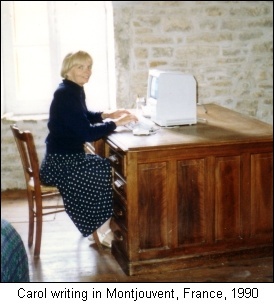 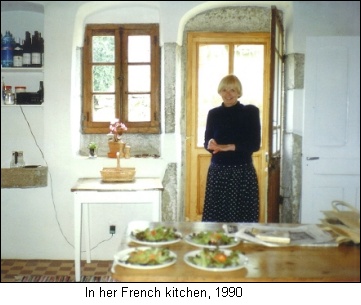
1990 was the year that Carol was discovered
by the English publisher, Fourth Estate. In that year, her novel
Swann: A Mystery, re-titled Mary Swann, appeared
in bookshops throughout the United Kingdom. Fourth Estate came
up with the idea of publishing Happenstance and A Fairly
Conventional Woman back to back in one volume called Happenstance:
Her Story and His Story. This was in 1991. Fourth Estate aggressively
promoted Carol and her books by making certain that the novels
were reviewed by the national newspapers in the UK. Fourth Estate
also entered her novels in competitions, where from time to time
they would be short listed for the award.
Carol's sixth novel, The Republic of
Love, was published simultaneously in Canada, the United States
and the United Kingdom in 1992. The setting for The Republic
of Love was the City of Winnipeg.
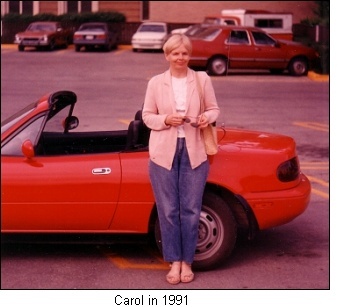 
I have lived in Winnipeg eleven
years. It somehow seems right to write about it. [In writing
The Republic of Love] the time had come to talk about Winnipeg
in the spring, summer and fall, and not just in the winter because
that is, of course, the stereotypical picture that we have of
it. I also wanted to talk about it as a cosmopolitan centre. It
does have more than a half million people, and I think that always
surprises people that it does function in this big city way. It
is an exotic city - the coldest city in the world - the coldest
large city I am told."
[Radio interview on publishing
The Republic of Love]
In 1992, Carol's third book of poetry —
Coming to Canada — was published.
Playwright
In the winter of 1982-83, Carol Shields decided to enter the Canadian
Broadcasting Corporation annual contest for an original radio play.
She won first prize for Women Waiting.
This success encouraged Carol to write her
first stage play, Departures and Arrivals. Departures
and Arrivals is a series of dramatic/comic scenes taking place
in an airport. It was first produced at the Black Hole Theatre,
University of Manitoba in 1984 and has since been adopted
by countless amateur theatre groups around the world, including
many schools and colleges.

The wonderful thing about writing
plays is you have a lot of people standing on the sidelines helping
you out. I was scared to death of that. I was afraid I would be
too protective of my play and not let anyone touch it. I have
to say that my fears were groundless. I have loved it and I have
been grateful for suggestions that have come from actors if they
have found a line, for example, difficult to say. Or if I hear
it out loud and suddenly it doesn't sound nearly as profound as
it did when it came out of my typewriter. In fact it sounds rather
silly. It's been a wonderful chance for me to simply take it out
and think about something else going in there. It can be frustrating
simply spending your creative time with a bunch of other people.
It's also exhilarating though, extraordinarily stimulating. In
fact Jacqui, the only real worry I have about this experience
is how I am ever going to be able to go back into the little room
and write books again. The wonderful thing, too, about working
with actors is they not only came amazingly close to that voice
that I had in my own head as I wrote the play, but they went beyond
that voice and did amazing things that I would never have thought
of. Now I suppose this is why the collaborative experience has
been so rewarding for me."
[Interview by Jacqui Goode,
CBC Radio re Departures and Arrivals]
Carol's second stage play, Thirteen Hands,
was first produced at Prairie Theatre Exchange in Winnipeg in
1993. Set around a bridge table through different generations
of players, the women in the play discover family histories, the
tricks of getting old and a companionship that gets passed on,
like an exquisite heirloom, to a next generation of bridge players.
The play went on to other professional theatres in Ottawa, Toronto
and Vancouver to considerable financial success.
With her daughter Catherine Shields, Carol
co-wrote a play for The Prairie Theatre Exchange in 1995. The
play was titled Fashion, Power, Guilt, and the Charity of Families.
And, with her colleague Dave Williamson, Carol co-wrote Anniversary
which was first performed in Toronto in 1994.
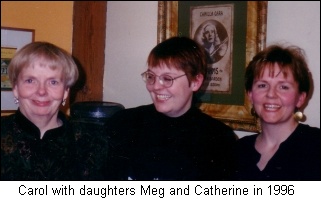
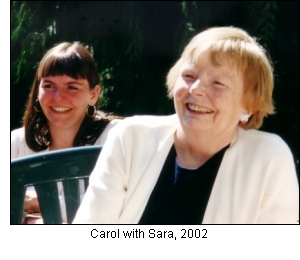 While
in England researching her biography of Jane Austen and working
on the novel Unless [see the following section - The Cancer
Years], Carol made a special journey to the Stephen Joseph Theatre
in Scarborough to see two plays. While there she accepted Alan
Ayckbourn's invitation to write a play for the Stephen Joseph
Theatre. After returning to Canada and moving to Victoria in 2000,
she subsequently asked her daughter Sara Cassidy to help her write
a stage play based on her novel Unless. In an article in
the Scarborough Evening News, April 6, 2005, Sara said: "Those
weeks went by too quickly, I saw how my mother worked and realised
how expertly she put words together for her readers. The work
thoroughly occupied her; every morning, she was radiant with new
ideas." Unfortunately Carol died in 2003 before they could
finish but Sara carried on and Unless: The Play was produced
in Scarborough as well as in Toronto and Vancouver in 2005 and
Victoria in 2006. While
in England researching her biography of Jane Austen and working
on the novel Unless [see the following section - The Cancer
Years], Carol made a special journey to the Stephen Joseph Theatre
in Scarborough to see two plays. While there she accepted Alan
Ayckbourn's invitation to write a play for the Stephen Joseph
Theatre. After returning to Canada and moving to Victoria in 2000,
she subsequently asked her daughter Sara Cassidy to help her write
a stage play based on her novel Unless. In an article in
the Scarborough Evening News, April 6, 2005, Sara said: "Those
weeks went by too quickly, I saw how my mother worked and realised
how expertly she put words together for her readers. The work
thoroughly occupied her; every morning, she was radiant with new
ideas." Unfortunately Carol died in 2003 before they could
finish but Sara carried on and Unless: The Play was produced
in Scarborough as well as in Toronto and Vancouver in 2005 and
Victoria in 2006.
Fame
1991 and 1992 in Winnipeg saw Carol Shields researching the customs
and daily happenings of the years 1905 to 1990 in Manitoba and
Indiana. Carol consulted mail-order-catalogues and newspapers
in order to better place Daisy Goodwill in her times. Daisy Goodwill
is the subject of a fictitious biography that was to become Carol
Shields' best known book: The Stone Diaries. Daisy was
born in 1905. As the title of the book implies, stone carving
and stone quarrying figured prominently in The Stone Diaries.
This meant that Carol traveled to the sources of limestone building
stone in quarries north of Winnipeg, quarries in the heartland
of Indiana, and quarries on the Island of Orkney.

A human life, and this is the
only plot I think that I am interested in, is this primordial
plot of birth, love, work, decline and death. This is just life
working away toward the end of life. What is the story of that
life? Can we tell our own life story with any sort of truth at
all? Of course, we know we can't. I mean, our life stories, whether
we write them or not, are a tissue of evasions, or, perhaps, enhancements.
So, that story that we carry around in our head, the story we
call our life, we can't know our birth and death, but we create
them somehow, imaginatively. There are other parts of our lives
in which we're quite happy to erase. There are other parts that
we want to touch up just a little bit. So what we end with is
a fiction. Our autobiography is a form of fiction."
[Interview for The Academy
of Achievement, May 23, 1998]
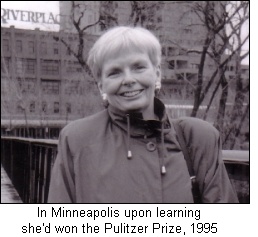 The
Stone Diaries was published in Canada and the United Kingdom
in 1993. It won Canada's Governor General Award for fiction that
year. The book was published in the United States in 1994, and
won US National Book Critics Award that year. Also in 1994, the
book won the McNally Robinson Award for Manitoba Book of the Year,
and the Canadian Booksellers Association Prize. In 1995, The
Stone Diaries won the Pulitzer Prize. More than a million
copies of The Stone Diaries have been sold. Fifteenth Anniversary
issues of The Stone Diaries were launched in Canada and
the United States in 2008. The
Stone Diaries was published in Canada and the United Kingdom
in 1993. It won Canada's Governor General Award for fiction that
year. The book was published in the United States in 1994, and
won US National Book Critics Award that year. Also in 1994, the
book won the McNally Robinson Award for Manitoba Book of the Year,
and the Canadian Booksellers Association Prize. In 1995, The
Stone Diaries won the Pulitzer Prize. More than a million
copies of The Stone Diaries have been sold. Fifteenth Anniversary
issues of The Stone Diaries were launched in Canada and
the United States in 2008.
The Maze and Labyrinth
Years
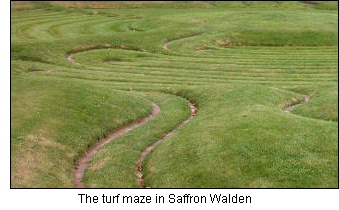 While
promoting a book in England in 1994, Carol came across a turf
maze in the town of Saffron Walden. Saffron Walden in Essex has
the largest public turf maze in England. It is 35m in diameter
and the path to the centre is 1,500m long! Of uncertain origin
(the earliest record is from 1699), the chalk path has been re-cut
several times, and is now laid with brick. This beautiful and
complete labyrinth has a raised bank surrounding it, and a central
mound with a socket-like depression which may have held a maypole
or similar focus. While
promoting a book in England in 1994, Carol came across a turf
maze in the town of Saffron Walden. Saffron Walden in Essex has
the largest public turf maze in England. It is 35m in diameter
and the path to the centre is 1,500m long! Of uncertain origin
(the earliest record is from 1699), the chalk path has been re-cut
several times, and is now laid with brick. This beautiful and
complete labyrinth has a raised bank surrounding it, and a central
mound with a socket-like depression which may have held a maypole
or similar focus.
Carol's imagination was immediately piqued
by this serendipitous happening. She bought a number of books
on mazes and labyrinths, and started to visit them wherever she
could - including probably the most famous labyrinth in Chartres
Cathedral, France. The labyrinth at Chartres was built around
1200, and is laid into the floor in a style sometimes referred
to as a pavement labyrinth.

For about a year after finishing
The Stone Diaries, I didn't know what to write next. Then, out
of a discussion I was having with some of my women friends about
what it means to be a man at this time in our history, I suddenly
got this notion that maybe I could write about a male character.
At the same time I was interested in mazes, and I thought maybe
I could bring these two things together."
[Interview with Sandra
Martin for Quill and Quire, February 1998]
Larry Weller, the man who gave his name to Carol's
next book Larry's Party, was a maze and labyrinth designer.
Larry's Party was published in 1997. It won the Orange Prize
and Le Prix de Lire. In 2001 Richard Ouzounian and his composer
collaborator, Marek Norman, opened their musical adaptation of
Larry's Party at the Bluma Appel Theatre in Toronto, starring
Tony Award winner Brent Carver, staged by acclaimed Canadian director,
Robin Phillips, and produced by the Canadian Stage Company.
Larry's Party was also performed at the Manitoba Theatre Centre
and the National Arts Centre. The play's script and four original
songs were published by McArthur and Co.
Honours
It was while researching and writing Larry's Party that
Carol received a number of honours. Principal among these was
her four-year appointment as Chancellor of the University of Winnipeg
in 1996.
In 1998, the Governor General of Canada
made Carol an Officer of the Order of Canada. She subsequently
(2002) was made a Companion of the Order of Canada - Canada's
highest honour.
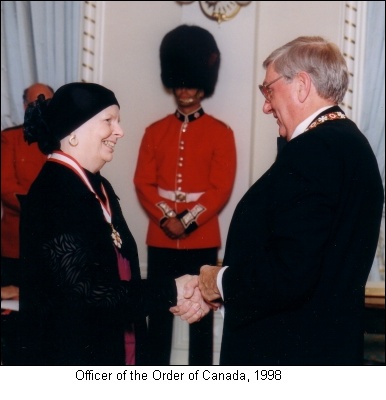
Also in 1998, Carol was made a Fellow of
the Royal Society of Canada.
Carol Shields received honourary degrees
from the University of Ottawa (1995), Hanover College (1996),
Queen's University (1996), University of Winnipeg (1996), University
of British Columbia (1996), and the University of Western Ontario
(1997). Later, while working on other books, Carol Shields received
honourary degrees from the University of Toronto (1998), Concordia
University (1998), Carleton University (2000), Wilfred Laurier
University (2000), Lakehead University (2001), University of Victoria
(2001), University of Calgary (2001), University of Manitoba (2003)
and Malaspina University and College (2003).
The Cancer Years
In December of 1998, Carol was diagnosed with Stage 3 breast cancer.
She was told that if she submitted to both surgery and radiation,
she would live, probably, for three years, provided that she undertook
chemotherapy as well.
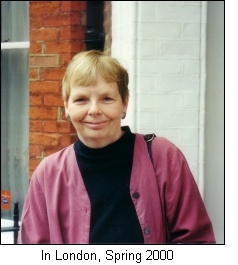 In
early 1999, Carol was approached by James Lipper. Lipper explained
that he would be the editor of a new series of short biographies
called Penguin Lives. The biographies would be published by Lipper-Penguin.
Carol was asked if she would agree to write the biography of Jane
Austen for the series. Carol agreed. In
early 1999, Carol was approached by James Lipper. Lipper explained
that he would be the editor of a new series of short biographies
called Penguin Lives. The biographies would be published by Lipper-Penguin.
Carol was asked if she would agree to write the biography of Jane
Austen for the series. Carol agreed.
A Guggenheim Fellowship was awarded to Carol
Shields in 1999. The Fellowship was intended to sponsor a sabbatical
leave in England while Carol started work on a new novel, Unless.
England was chosen as the locale for the sabbatical year because
staying in England would facilitate Carol's research on a biography
of Jane Austen.
It so happened that Carol had spent the
summer of 1975 reading Jane Austen:

I've been reading Jane Austen
all summer, partly as a cushion against cultural shock [living
in France], but partly out of curiosity. In the introduction to
one of her books the editor admits that she writes about extraordinarily
dull affairs but nevertheless the reader feels compelled to keep
turning the page. I am on the sixth and last book now and I still
haven't quite managed to figure out what magic she has."
[A Memoir of Friendship:
Letters between Carol Shields and Blanche Howard]
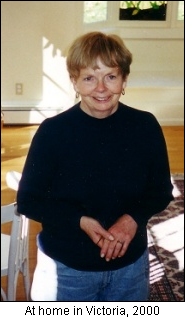 In
an interview about writing Jane Austen, Carol remarked: In
an interview about writing Jane Austen, Carol remarked:

I've written quite a bit about
other people writing biographies, but I've written one myself,
about Jane Austen. It's part of a series, mainly by novelists
rather than professional biographers. When editors offered me
Jane Austen, I couldn't resist. But I don't think biography is
my thing. I found it a little bit tedious, even though I am very
interested in Jane Austen's life. It was a bit of a chore, putting
facts together and not having room to embellish. With my own writing,
I'm interested in the idea of the arc of a human life, as a plot
in itself. It's the only plot I'm really interested in. Plots
seem quite contrived things, and I don't think writers can get
away with them in the way they once did. I think books have changed
in that sense. People aren't willing to be so manipulated any
more."
[Interview with Ruth Thomas
for The Scottish Book Collector in 2000]
Carol's Jane Austen was published
in 2001. It won the Charles Taylor Prize for non-fiction in 2002.
Before accepting the request from Penguin
Publishers that she write a biography of Jane Austen, Carol had
been mulling over the idea of ‘goodness’. As she explained to
Eleanor Wachtel: 
I have been interested in the idea
of goodness for a number of years. I certainly believe in it.
I’m like those people who talk about modern art, and they say,
“I don’t understand it but I know it when I see it.” I feel
I know goodness when I see it, But have a hard time defining
what it is.”
[Random Illuminations,
Eleanor Wachtel]
In the novel Unless, nineteen-year-old
Nora leaves home and sits mute on a street corner begging for
money. Around her neck is hung a sign “Goodness”. Nora’s family
is devastated, as they search for reasons why Norah would abandon
her university studies, her boyfriend and her family. And, they
ask themselves, Why goodness? Unless is Carol Shields’
most overtly feminist book. It was published in 2002 to great
critical acclaim, being shortlisted for the Man-Booker Prize,
the ScotiaBank-Giller Prize, and the Governor General’s Award
for Fiction in 2002. In 2003 Unless was nominated for the Orange
Prize for fiction and won the Ethel Wilson Prize for fiction.
Unless was ranked in the top 10 of a list of Britain’s
all-time best loved books by women.
Carol was notified by France's Minister
of Culture and Communications in 2000 that she had been made a
Chevalier dans l'ordre des Arts et des Lettres.
In 2001, Carol received The Order Of Manitoba,
and she was made Winnipeg's Citizen Of The Year.
2002 saw Carol Shields awarded the Queen
Elizabeth Golden Jubilee Medal. Also in 2002, she was made a Companion
of the Order of Canada - Canada's highest honour.
On July 16, 2003, Carol Shields died of
breast cancer.

I've had a lucky life. I've been lucky in friendship and lucky
in love. And, having a lot of the big pieces of life: having
children, having consuming passions, intellectual passions.
That has enormously enriched my life. There are all kinds of
things that I know nothing about, but I always had something
that consumed me. So I think I've been lucky, and that has given
me a sense of happiness."
[ Top ]
|



